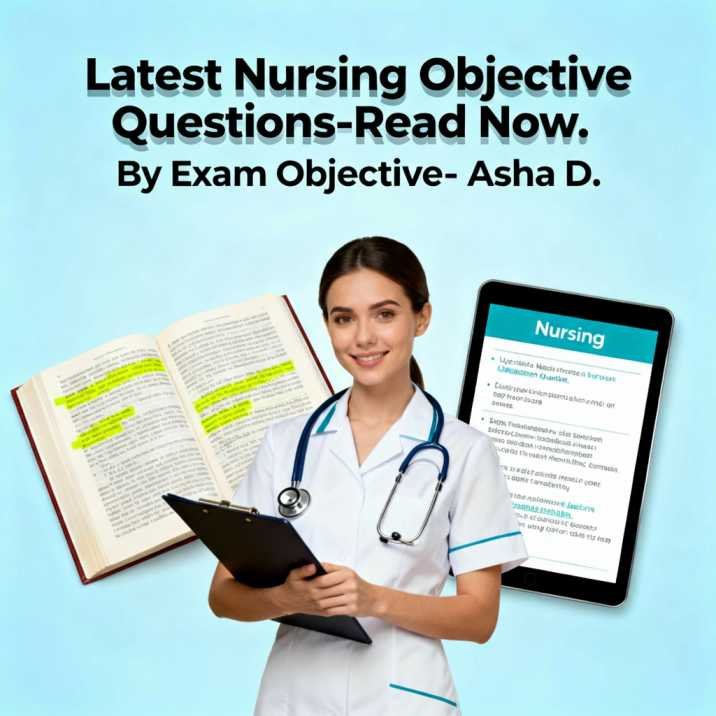🌍 Latest Nursing Exam-Oriented MCQs 🌍
Strengthen your preparation with fresh, high-quality Nursing MCQs crafted to support success in major exams like NCLEX, HAAD, MOH, Prometric, DHA, AIIMS, RRB, NHM, and State Nursing Exams.
These questions cover essential concepts across Medical-Surgical, Pediatric, Psychiatric, Community Health, and Obstetric Nursing to help you build solid core knowledge.
Practice consistently, stay motivated, and move steadily toward your dream of becoming a competent and confident nursing professional. 💉📘🌟
IgM is the first antibody that our body makes when a new infection starts, so it basically kicks off the initial immune response. The other options don’t fit because IgM is produced by vertebrates, it is definitely an antibody isotype, and it’s actually the largest antibody, not the smallest. So option B is the correct one.
In a prolapsed cord, the main goal is to take pressure off the cord so the baby keeps getting oxygen. Elevating the mother’s hips or using a knee-chest position helps lift the fetus off the cord. The nurse should never try to push the cord back in, and covering it dry won’t help because it needs to stay moist. So lifting the hips is the quickest and most effective action in this emergency.
Emptying a Foley bag is a routine, stable task that nursing assistants are trained to do, even for clients like those with preeclampsia. Seclusion requires RN authority, feeding a dementia client can be risky because of choking concerns, and ambulating someone with a fractured hip needs more assessment and supervision. So the safest and most appropriate task for the NA is emptying the Foley.
Pain, redness, warmth, and tenderness along the vein usually point toward phlebitis, which is basically inflammation of the vein caused by the IV. Infiltration and extravasation are more about swelling and coolness because the fluid leaks out, not warmth. Hematoma shows bruising rather than redness with heat. So these symptoms match phlebitis the most.
The surgical safety checklist mainly focuses on patient identity, the correct procedure, allergies, instruments, medications, and ensuring the team is ready. Counselling is important in general care, but it’s not part of the formal WHO surgical checklist. So option D is the one that doesn’t belong there.
After a thyroidectomy the biggest concern is bleeding into the neck that can compress the airway. Having a tracheotomy set at the bedside ensures that if airway compromise happens quickly, the team can perform an emergency surgical airway. The other options don’t offer the same rapid airway access in that surgical-bleed scenario.
Histoplasmosis is usually caught from inhaling spores found in bird or bat droppings, especially in old buildings, caves, or places with lots of birds around. It’s not spread by cats, dogs, or turtles, so birds are the correct source linked to the infection.
Neural tube defects mostly happen when there isn’t enough folic acid during early pregnancy. Folate is essential for proper closure of the neural tube, so its deficiency increases the risk a lot. The other options don’t directly cause NTDs the same way folate deficiency does.
🌍 Nursing excellence knows no borders — prepare smart for global exams! 🌍
💡 Master each concept — your knowledge can save a life anywhere in the world! 💡
✅ Drop your answer below and challenge nurses worldwide!
🤝 Let’s learn together — inspire, support, and grow as global nursing professionals!
📚 Read More Nursing Objective Questions (MCQ)
Continue learning topic-wise! Tap any subject below to explore detailed Nursing MCQs with answers, explanations, and practice sets — designed for BSc, GNM, ANM, and MSc Nursing students.
📰 Related Nursing Articles & Updates

100 Nursing MCQ Questions with Answers — Must-Know Topics for Exam Preparation 🩺

Complete Collection of Nursing MCQ Questions – All Subjects in One Place 📘

🔥 Latest Nursing Objective Questions — Recently Added for 2025 Exams

🔥 Nursing multiple choice questions and answers pdf free download- By Asha D.